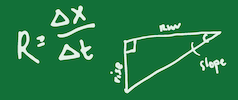Guiding students through Probability
An instructor's guide to Probability
Emma MacKie (University of Florida)
Alex Tye (Utah Tech University)
What should students get out of this module?
After completing this module, a student should be able to:
- Compute the probability of the occurrence of a geologic event based on a record of observations.
- Determine the probability that geoscientific events such as major earthquakes or floods will occur within a given interval or timeframe.
- Solve for the number of years (or some spatial interval) that is required to exceed some probability or risk that a given geological event will occur.
Why are these math skills challenging to incorporate into courses?
Probability is typically not taught outside statistics courses, which most geoscience students have not taken. As such, geoscience students typically have limited exposure to probability. Furthermore, probability courses typically do not include examples that are relevant to the geosciences, making it difficult to transfer this knowledge to our domain. Specifically, there is often a mismatch between the types of examples used in probability courses, which are simple and well-understood repetitive events (e.g., coin flips, dice, playing cards), and the complex, poorly constrained events and processes that geoscientists model using probability. Real-world probabilistic analysis in Earth science research is often quite advanced, so there is a limited availability of simple example problems for building foundational probability skills.
What we don't include in the page?
Our module is designed for students who are not familiar with basic probability mathematics, such as calculating the probability of an event based on observations, using compound and complementary probabilities, and casting problems in terms of probability. As such, we avoid more advanced topics even where they would have significant applicability in geosciences. Our materials are restricted to scenarios involving single events or observations that may or may not occur, as well as relatively simple combinations of such events. We do not include binomial coefficients ("n choose k" notation), which could be used to extend our approach to more generalized scenarios such as the probability of observing a set of outcomes from a set of experiments. We do not explicitly present probability distributions, such as binomial, Poisson, or Gaussian/normal distributions, or their formulas, expected values, or how to estimate their parameters. We do not introduce probability density functions or cumulative distribution functions. Finally, we do not include conditional probability or its extension to Bayes' Theorem and Bayesian inference.
Instructor resources
Support for teaching this quantitative skill
- One or more other resources that can help instructors teach about this topic. SERC collections such as Teaching Quantitative Skills can be a helpful place to look.
- Just How Faithful is Old Faithful? Finding Order in Random Behavior is an instructor guide for probabilistically characterizing the eruption behavior of the Old Faithful geyser.
- Two streams, two stories... How Humans Alter Floods and Streams is an instructor guide for making probabilistic estimates of flood occurrence.
Examples of activities that use this quantitative skill
- How wet is the Earth? is an activity guide for using probability to estimate the water coverage of the Earth.
- Determining Earthquake Probability and Recurrence from Past Seismic Events is a classroom activity for estimating the recurrence level of large earthquakes.
- M&M Model for Radioactive Decay is an activity for probabilistically modeling isotope decay.
